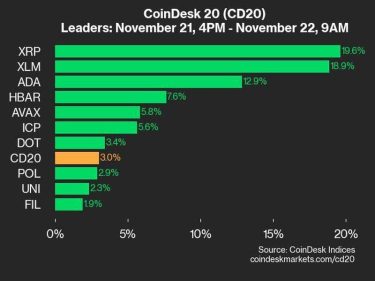-
Last week, bitcoin rallied 17%, its second-best week of the year.
-
Bitcoin’s spot volume on Coinbase soared, nearing the March 2024 high.
-
Exchange balances for the largest cryptocurrency hit a year-to-date low, a sign of increased buying pressure, according to Glassnode data.
Donald Trump’s U.S. presidential election victory sparked a roaring few days for cryptocurrencies, with bitcoin (BTC) surging to a record and total cryptocurrency market cap eclipsing $2.7 trillion, a high for the year.
Bitcoin, at $1.16 trillion, is now the ninth-largest financial asset by market capitalization. The biggest cryptocurrency registered its second-best week of the year, rising 17%. That’s just shy of the 22% climb in the week ended March 3, according to Glassnode data.
:format(jpg)/cloudfront-us-east-1.images.arcpublishing.com/coindesk/73C7HWQ3HZFI5KESEPPRZGIEWA.png)
To understand whether the bitcoin could theoretically climb higher or if this marks a local top, it’s essential to understand who is buying bitcoin and whether it’s a spot or leverage-driven rally.
First, let’s consider the spot cumulative volume delta (CVD), which Glassnode defines as “measuring the net difference between buying and selling trade volumes, specifically highlighting the difference in volume where the buyer or seller was the aggressor. It includes trades where USD or USD-related currencies serve as the quote currency, encompassing both fiat and stablecoins.”
Most of the spot CVD is coming from Coinbase, a crypto exchange widely used by U.S. investors and institutions, and coincides with a spike in the Coinbase Premium Index.
Zooming out over the past three years, it’s apparent that when Coinbase CVD spikes, it tends to be near local highs and lows. In March, one of the highest CVD levels occurred as bitcoin broke its then-record high above $73,000. There were also high levels near cycle lows around the Luna and FTX collapse in 2022, which shows smart money buying near the bottom and others buying near the top.
There’s been much deliberation about whether inflows into U.S. listed spot exchange-traded funds (ETFs) are spot buying alone or if they’re part of a strategy known as the basis trade.
The basis trade is a technique for profiting from the discrepancy between spot and futures prices. It involves an investor holding a long position in an ETF while taking a short position in the Chicago Mercantile Exchange (CME) futures market, capturing the price spread.
At the start of the year, when the ETFs were introduced, there were huge inflows. Since then, however, bitcoin has mostly held steady, showing that the ETFs didn’t affect the price as much as investors thought, largely due to their operating a delta-neutral strategy.
Last month, the CEO of crypto index provider CF Benchmarks told CoinDesk that “40% of the ETF inflows were directly down to the basis trade.” However, as the ETF inflows continued to set records, open interest in the CME exchange has not followed suit.
Bitcoin analyst Checkmate has also observed this trend:
“Spot bitcoin ETF inflows have massively outpaced the growth in CME open interest last week. True directional spot buying has returned. Monday likely to see FOMO and momentum buyers as well,” they said in a post on X referring to the fear some buyers have of missing out on a rally.
:format(jpg)/cloudfront-us-east-1.images.arcpublishing.com/coindesk/5CWL5OC3QBHQXLRDTR6C6IPJI4.png)
Glassnode data shows that bitcoin on exchanges has hit a year-to-date low at 2.95 million BTC. Since the Nov. 5 election, there’s been a reduction of some 40,000 BTC, and demand appears to come from multiple exchanges such as Coinbase, Binance, and Bitfinex. Lower balances on exchanges indicate that bitcoin owners are looking to buy more bitcoin.
:format(jpg)/cloudfront-us-east-1.images.arcpublishing.com/coindesk/UIEC6USQNRBWXKQB7CZZS35C6U.png)








